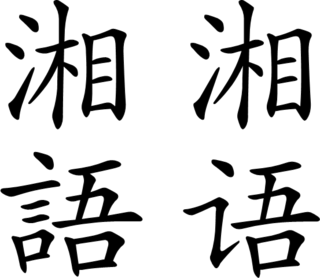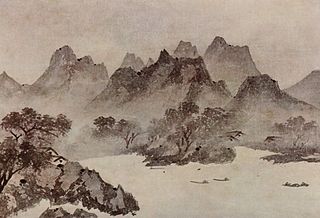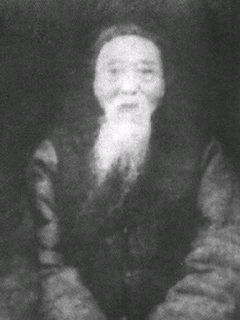
Hunan is a landlocked province of the People's Republic of China, part of the South Central China region. Located in the middle reaches of the Yangtze watershed, it borders the province-level divisions of Hubei to the north, Jiangxi to the east, Guangdong and Guangxi to the south, Guizhou to the west and Chongqing to the northwest. Its capital and largest city is Changsha, which also abuts the Xiang River. With a population of just over 67 million as of 2014 residing in an area of approximately 210,000 km2 (81,000 sq mi), it is China's 7th most populous province and the 10th most extensive province by area. Its 2020 nominal GDP was more than US$600 billion, appearing in the top 30 largest sub-national economies in the world with its PPP GDP being over US$1 trillion.

Changsha is the capital and the largest city of Hunan Province of the People's Republic of China. It is the third-most populous city in Central China, located in the lower reaches of Xiang River in northeastern Hunan. Changsha is also called Xingcheng and was once named Linxiang, Qingyang (青阳) in ancient times. It is also known as Shanshuizhoucheng (山水洲城), with the Xiang River flowing through it, containing Mount Yuelu and Orange Isle. Changsha is the core city of Chang-Zhu-Tan City Cluster and a supercity in China, one of the core cities in Central China. It's also a National Comprehensive Transportation Hub, and one of the first National Famous Historical and Cultural Cities in China. Changshanese, a kind of Xiang Chinese, is spoken in the downtown, while Ningxiangnese and Liuyangnese are also spoken in the counties and cities under its jurisdiction.

Dongting Lake is a large, shallow lake in northeastern Hunan Province, China. It is a flood basin of the Yangtze River, so its volume depends on the season. The provinces of Hubei and Hunan are named after their location relative to the lake: Hubei means "North of the Lake" and Hunan, "South of the Lake".

The Xiang River is the chief river of the Lake Dongting drainage system of the middle Yangtze, the largest river in Hunan Province, China. It is the 2nd largest tributary in terms of surface runoff, the 5th largest tributary by drainage area of the Yangtze tributaries. The river flows generally northeast through Guangxi and Hunan two provinces, its tributaries reach into Jiangxi and Guangdong.
Ningxiang is a county-level city and the 2nd most populous county-level division in the Province of Hunan, China; it is under the administration of the prefecture-level city of Changsha. The city is bordered to the north by Heshan District of Yiyang and Taojiang County, to the west by Anhua County and Lianyuan City, to the south by Louxing District of Loudi, Xiangxiang City, Shaoshan City and Yuhu District of Xiangtan, to the east by Yuelu and Wangcheng Districts. Located in the central east of Hunan Province, Ningxiang covers 2,906 km2 (1,122 sq mi) with a registered population of 1,393,528 and a resident population of 1,218,400. The city has 4 subdistricts, 21 towns and 4 townships under its jurisdiction, its administrative centre is at Yutan Subdistrict (玉潭街道).

Yuelu District is one of six urban districts of the prefecture-level city of Changsha, the capital of Hunan Province, China. It is the 4th most populous district in Hunan. The district is bordered to the north by Wangcheng District, to the west by Ningxiang County, to the south by Yuhu District of Xiangtan City, across the Xiang river to the west by Tianxin, Furong and Kaifu Districts. Located on the west bank of the Xiang River, as the western part of the City proper, the district is named after Mount Yuelu, one of the national parks, Yuelu District covers 538.83 km2 (208.04 sq mi) with registered population of 644,834 and resident population of 818,900. The district has 16 subdistricts and 2 towns under its jurisdiction, its administrative centre is at Wangyue (望岳街道).

Xiang or Hsiang ; Changsha Xiang: sian1 y3, also known as Hunanese, is a group of linguistically similar and historically related Sinitic languages, spoken mainly in Hunan province but also in northern Guangxi and parts of neighboring Guizhou and Hubei provinces. Scholars divided Xiang into five subgroups, Chang-Yi, Lou-Shao, Hengzhou, Chen-Xu and Yong-Quan. Among those, Lou-shao, also known as Old Xiang, still exhibits the three-way distinction of Middle Chinese obstruents, preserving the voiced stops, fricatives, and affricates. Xiang has also been heavily influenced by Mandarin, which adjoins three of the four sides of the Xiang speaking territory, and Gan in Jiangxi Province, from where a large population immigrated to Hunan during the Ming Dynasty.

The Hunanese people or Xiang-speaking Chinese are a Xiang-speaking Han Chinese ethnic subgroup originating from Hunan province in Southern China, but Xiang-speaking people are also found in the adjacent provinces of Guangxi and Guizhou.
Embroidery City is the biggest embroidery products production base in China. It is also included in the China National Intangible Cultural Heritage Protection and Research Base for the following functions: it researches and produces Hunan embroidery, clothes and home textiles, Chinese ceramics and silver jewelry and retains the production process of China's traditional crafts.
Xiangyin County is a county in Hunan Province, China, it is under the administration of Yueyang City. Located on the southeastern shores of Lake Dongting, the Xiang River runs south to north through the middle lands of the county, the Zi River merges into Dongting in the westeastern margin. Xiangyin is bordered by Yueyang County, Yuanjiang City to the north, Heshan District of Yiyang to the west, Wangcheng District of Changsha to the south, Miluo City to the east. It has an area of 1,581.5 km2 (610.6 sq mi) with rough 770,000 of population, the county is divided into 14 township-level divisions, the county seat is Wenxing Town.

Xiaoxiang, also transliterated XiaoXiang, Hsiao Hsiang, and Chiu Chiang, in some older sources, refers to the "lakes and rivers" region in south-central China south of the middle-reaches of the Yangtze River and corresponding, more or less, with Hunan province. Xiaoxiang is less a precise geographic entity than a concept. Xiaoxiang is used in the genre of Xiaoxiang poetry of Classical Chinese poetry and in literature for symbolic purposes, in part because this was a significant area, which at least through the Song dynastic era China was still considered a wild place full of malaria, barbarians, and wild beasts. Indeed, for much of early Chinese history, this area belonged not to China, but to the independent state of Chu. Beginning at least with Qu Yuan, in the third century BCE, this region came to symbolically represent the unjust exile of a talented minister or government official by an unappreciative king or emperor.

Xiangtan is a prefecture-level city in east-central Hunan province, south-central China. The hometowns of several founding leaders of the Chinese Communist Party, including Chairman Mao Zedong, President Liu Shaoqi, and Marshal Peng Dehuai, are in Xiangtan's administration, as well as the hometowns of Qing dynasty painter Qi Baishi, scholar-general Zeng Guofan, and tennis player Peng Shuai.

New Xiang, also known as Chang-Yi is the dominant form of Xiang Chinese. It is spoken in northeastern areas of Hunan, China adjacent to areas where Southwestern Mandarin and Gan are spoken. Under their influence, it has lost some of the conservative phonological characteristics that distinguish Old Xiang. While most linguists follow Yuan Jiahua in describing New Xiang as a subgroup of Xiang Chinese, Zhou Zhenhe and You Rujie classify it as Southwestern Mandarin. However, New Xiang is still very difficult for Mandarin speakers to understand, particularly the old style of New Xiang.

Xiaoxiang poetry is one of the Classical Chinese poetry genres, one which has been practiced for over a thousand years. It is a poetry of scenic wonders, a poetry of officials exiled for their views and beliefs, and a poetry of dissent against submitting to government control. Xiaoxiang poetry is geographically associated with the Xiaoxiang region, around and south of Dongting Lake. The Xiaoxiang genre of literature is often associated with similarly themed Chinese calligraphy and Chinese painting. Famous poets in this genre include Qu Yuan, Song Yu, Jia Yi, Wang Yi, Yu Xin, Shen Quanqi, Zhang Yue, Li Bai, Du Fu, Han Yu, Liu Zongyuan, and Su Shi.

Jinggang is a town in Wangcheng district, Changsha, Hunan province, China. The town is located on the west bank of Xiang river, and bordered by Qiaokou to the north, Zhuliangqiao and Shuangjiangkou of Ningxiang to the west, Gaotangling to the south, Tongguan across the Xiang river to the east. It covers 92.47 km2 (35.70 sq mi) with 67.3 thousand of population. The Jinggang town was formed by the former Jinggang and Getang towns on November 19, 2015. According to the result of 2016 adjustment programmes on village-level divisions (村级区划调整), the town has two residential communities and 10 villages under its jurisdiction; the administrative office is at Nongxi village (农溪村).
Changsha has a history going back over 3000 years. It has grown to an important town of economy, culture and garrison in the southern area of Chu State. In the Later Tang dynasty (923-936), the king of Chu, Ma Yin, founded the Chu Kingdom (927-963) and set it as the capital, the city quickly became the largest and most important population, commercial and financial center in southern China. It was devastated by the Second Sino-Japanese War and the Wenxi Fire in 1938 but was quickly rebuilt. As of 2016, Changsha was ranked 13th of cities of China by comprehensive strength in 2016.
Hunan embroidery, or Xiang embroidery, as one of the traditional folk arts of China, together with Suzhou embroidery, Sichuan embroidery, and Cantonese embroidery, is regarded as the four most distinguished embroidery styles in China. It is a general name for the embroidery products which rise from and are mostly produced at Changsha, Hunan, with distinct characteristics of Chu culture. Hunan embroidery is particularly famous in embroidering with silk thread, and the patterns have a high sense of reality. In 2006, Hunan embroidery was selected into the first batch of national intangible cultural heritage list.
The Xiangxiang dialect is a dialect of Xiang Chinese, spoken in Xiangxiang, Hunan province, China. It is part of a group of dialects called the Central Xiang dialects.

Mount Zhao is a 185 metres (607 ft) mountain on the border of Xiangtan and Changsha in Hunan, China. Towering by riverside of the Xiang River, it has guarded the estuary of Xiang River and controlled the center of Hunan. It has been designated as a provincial-level scenery area by the government of Hunan in 1991 for its long history, superb environment, unique landscape and cultural attraction.

Wang Kaiyun, courtesy name Renqiu and Renfu, was a Chinese scholar and litterateur.
















